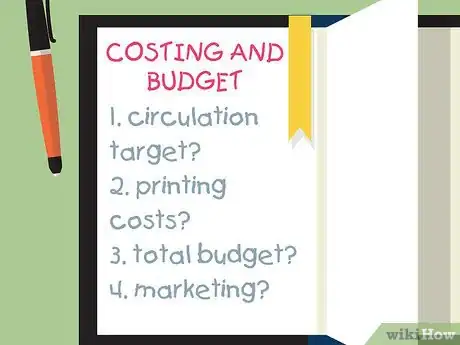wikiHow is a “wiki,” similar to Wikipedia, which means that many of our articles are co-written by multiple authors. To create this article, 56 people, some anonymous, worked to edit and improve it over time.
wikiHow marks an article as reader-approved once it receives enough positive feedback. This article received 21 testimonials and 93% of readers who voted found it helpful, earning it our reader-approved status.
This article has been viewed 466,169 times.
Learn more...
If there's something you're really passionate about, self-publishing your own magazine can be a fun way to share it with an audience! We'll help you get your magazine up and running, from researching your competition to finalizing your layout and sending out copies.
Steps
-
1Research. Don't kid yourself. Creating and self-publishing a magazine can end up being an expensive task, both mentally and financially. Research is required![1]
- Is there a magazine currently in circulation that is already providing similar content?
- What makes it a winner?
- What makes it a loser?
- How will your magazine be better?
- Or, will your magazine be absolutely the only one of its kind reaching your target demographic?
- What is your target demographic looking for in a magazine?
- What other magazines are targeting the same demographic?
- From which can you learn the successes?
- From which can you learn the failures?
-
2Consider your options and costs, together. Realistically. We know your circulation will be one million copies by the end of the first year, and your profit margin will be 85%. But, let's pretend, just for fun, that you might have a few hiccups along the way.[2]
- What are your printing options versus your budget?
- How many pages need to be color, and how many can be black and white?
- What is your circulation target?
- What are your circulation and distribution options?
- Is sponsorship an option?
- Is it possible to secure advertisers for your first run before going to press?
Advertisement -
3Find your exact audience - not just the general audience. You need to know exactly who your target demographic is. Without knowing this, it will be difficult to properly layout your magazine content, market your magazine, or secure serious advertisers. Assuming you know quite a lot about your magazine's subject, this shouldn't be too difficult. Sign up for discussion groups (such as Yahoo), subscribe to other magazines, join local groups, etc.[3]
-
4Create a website. Before you get the word out about your new endeavor, you MUST publish a website. Work to make the site as professional as possible. Don't advertise the fact that this is a one-person gig.[4]
- On your site, you should have a page for contributors. This allows you to mark deadlines, point out what sorts of articles you'd like to receive, and let writers know how you'll be using their work. List your pay rates and what rights you intend to purchase.
- You should also have a way for people to subscribe online, if at all possible. Paypal is a good way to do this, at least when you're just starting out. If you don't want to take subscription orders online, make sure your address is easy to find and note what forms of payment you DO take. If you accept checks or money orders, you'll need to get a DBA (doing business as) so that your bank will accept checks made out to your magazine name.
-
5Solicit articles. Post a "call for submissions" to your newfound groups. Try to get your notice on a few high traffic blogs. If you're looking for more general articles, try posting your notice at the local library. Consider placing a classified ad in magazines with a cross-over audience. A call for submissions will not only net you articles; it will drum up anticipation for your new publication. Don't forget to point people to your website!
-
6Search out advertisers. Since your magazine isn't established, you might consider charging a nominal amount for ads ($20-$50). Consider who might want to advertise in your publication, and don't be squeamish about contacting them. Be bold. You might look for members of your online discussion groups who place business links in their signatures.[5]
-
7Edit. Once you're armed with a binder full of possible articles, choose the most interesting, best-written pieces of the bunch, and grab your red pen. Try not to be too heavy-handed. Writers will submit more often to an editor who doesn't mangle their work.
-
8Send the edited articles back to the writers for them to look over. You don't necessarily have to wait for them to approve all changes, but allow them to question or challenge any editorial decisions you've made.
-
9Begin laying out the magazine. Professionals use desktop publishing (DTP) software such as QuarkXPress (the industry standard), Adobe InDesign (or the older version, PageMaker) but Scribus and even word processors (which can handle layout) such as OpenOffice.org Writer are free. Get to know your layout program inside and out. Look at other magazines for design tips. You might also check out books devoted to the subject. Have the authors sent you photos to run with their work? Do you have photos of your own? If not, consider purchasing stock photos (easily found on the Internet). Buying a bundle of cheap stock photos may be the best purchase you ever make.[6]
-
10Once you've got the layout set - inside cover, outside cover and pages - find yourself a reliable, well-priced print shop. Printers' prices vary greatly, so plan on spending some time asking around and getting samples. Look for one that will do laser, rather than off-set, printing. This will save you TONS of money.
-
11If you're starting cheap, buy yourself a decent black and white laser printer with duplexing. Duplexing will prove to be the most important feature of the printer. If you put some time into your search, you should be able to find a good printer for a few hundred dollars. This should be sufficient for the inside pages. The cover should still be done at a print shop, if at all possible.
-
12While you're busy printing, market the heck out of your publication. Online groups, other magazines, blogs (consider starting your own), MySpace, Google's AdWords, etc.
-
13Send out the magazines! Keeping a database of subscribers might only need a spreadsheet program such as Excel or the free OpenOffice.org Calc but a dedicated database program is better. Make sure to talk with your post office about the best way to send out your new publication. They'll have great, time-tested ideas and may be able to save you quite a bit in postage costs.
Community Q&A
-
QuestionCan I create a magazine using only pictures?
 Community AnswerIf you're creative enough, then yes. However, you'd still need some words for titles, the copyright and publisher's information and an editorial at the beginning. If the pictures were brilliant and self-explanatory for the topic, then you could probably get away with mostly images for the whole magazine. If you're adding advertisements, they'll have text though.
Community AnswerIf you're creative enough, then yes. However, you'd still need some words for titles, the copyright and publisher's information and an editorial at the beginning. If the pictures were brilliant and self-explanatory for the topic, then you could probably get away with mostly images for the whole magazine. If you're adding advertisements, they'll have text though. -
QuestionHow do I make money with an online magazine?
 Community AnswerMaking money from an online magazine is very similar to a physical magazine. Use well-placed advertisements, charge a small subscription fee for your online publication, set up a small store or merch store related to you magazine etc.
Community AnswerMaking money from an online magazine is very similar to a physical magazine. Use well-placed advertisements, charge a small subscription fee for your online publication, set up a small store or merch store related to you magazine etc. -
QuestionHow much will it cost to make a thousand copies of a magazine?
 Community AnswerTo price this, you first need to consider length, how many pages you're making colored, the print quality, lamination, etc. A thousand copies can cost as low as $500 and as much as $3000.
Community AnswerTo price this, you first need to consider length, how many pages you're making colored, the print quality, lamination, etc. A thousand copies can cost as low as $500 and as much as $3000.
Warnings
- Don't be afraid to ask for help when you need it.⧼thumbs_response⧽
- You May need to hire a few of your friends to help you do it just give them some of the profit!⧼thumbs_response⧽
- Be prepared to grow. The more subscribers you have, the more time you'll have to spend dealing with them.⧼thumbs_response⧽
- Keep on schedule. It's so easy to slip behind, and your subscribers won't be pleased.⧼thumbs_response⧽
Things You'll Need
- A good black and white laser printer with duplexing capabilities.
- A reliable printing service for your covers.
- A saddle stapler.
- Word, as well as software programs, for layout, photo editing, and spreadsheets.
- It helps if you have Photoshop
References
- ↑ https://blog.markgrowth.com/how-to-self-publish-your-magazine-and-increase-your-business-reach-3e7d13424ad0
- ↑ https://blog.markgrowth.com/how-to-self-publish-your-magazine-and-increase-your-business-reach-3e7d13424ad0
- ↑ https://medium.com/the-mission/how-to-self-publish-a-magazine-in-30-days-12038a8b3bb8
- ↑ https://www.entrepreneur.com/article/160238
- ↑ https://www.entrepreneur.com/article/160238
- ↑ https://medium.com/the-mission/how-to-self-publish-a-magazine-in-30-days-12038a8b3bb8









































































